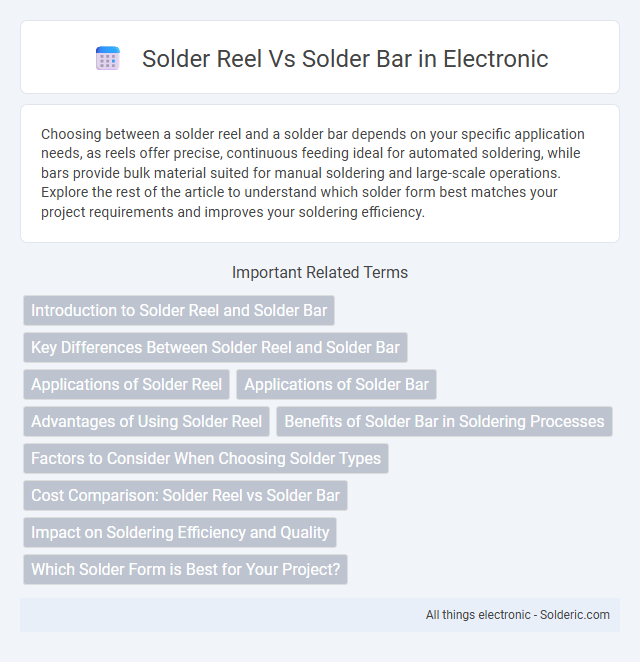Choosing between a solder reel and a solder bar depends on your specific application needs, as reels offer precise, continuous feeding ideal for automated soldering, while bars provide bulk material suited for manual soldering and large-scale operations. Explore the rest of the article to understand which solder form best matches your project requirements and improves your soldering efficiency.
Comparison Table
| Feature | Solder Reel | Solder Bar |
|---|---|---|
| Form | Coiled wire on spool | Solid rectangular/rod shape |
| Application | Wave and selective soldering, precision work | Manual soldering, mass melting |
| Ease of Use | Easy feed, controlled dispensing | Requires melting and cutting |
| Storage | Compact, organized spools | Bulky, requires space |
| Typical Materials | Sn63Pb37, SAC305, lead-free alloys | Sn63Pb37, Sn99.3Cu0.7, lead-free alloys |
| Cost Efficiency | Higher per unit cost, less waste | Lower unit cost, more waste |
| Common Use Industries | Electronics manufacturing, precision assembly | Metalworking, plumbing, bulk soldering |
Introduction to Solder Reel and Solder Bar
Solder reel and solder bar are two common formats of solder used in electronics and metal joining applications. Solder reels consist of thin solder wire wound on a spool, ideal for precise, continuous application in automated or manual soldering. Solder bars, typically solid blocks, are melted down for bulk soldering processes or casting, providing a versatile source of solder material for large-scale or custom use.
Key Differences Between Solder Reel and Solder Bar
Solder reels consist of thin, flexible solder wire wound around a spool, allowing precise application and easy feeding for automated soldering processes, whereas solder bars are solid, rectangular blocks used primarily for remelting and casting into custom shapes. Solder reels offer convenience and efficiency in electronics assembly with consistent diameter and flux core options, while solder bars provide versatility for large-scale melting and alloy blending applications. The choice between solder reel and solder bar depends on the specific manufacturing needs, volume, and method of solder application.
Applications of Solder Reel
Solder reels are widely used in automated soldering processes due to their convenience and compatibility with soldering machines, making them ideal for large-scale electronics manufacturing. They provide consistent solder feed and reduce waste compared to solder bars, which are typically used in manual or batch processing. Your production line benefits from solder reels when precision, efficiency, and continuous operation are prioritized in applications like PCB assembly and wave soldering.
Applications of Solder Bar
Solder bar is primarily used in wave soldering and manual soldering processes where large volumes of solder are required, providing consistent alloy composition and superior thermal conductivity. It is ideal for applications in electronics manufacturing, such as PCB assembly, and metal joining tasks in plumbing and automotive industries. The solid form of solder bar allows for easy remelting and alloy customization, enhancing its versatility in various industrial soldering operations.
Advantages of Using Solder Reel
Solder reels offer precise control and reduce waste by dispensing only the amount needed, making them ideal for detailed soldering tasks in electronics. Their compact design ensures easy handling and storage compared to bulky solder bars, enhancing efficiency in your projects. Using a solder reel also minimizes oxidation and contamination, preserving solder quality throughout extended use.
Benefits of Solder Bar in Soldering Processes
Solder bars offer superior thermal efficiency, allowing faster melting and improved heat transfer in soldering processes compared to solder reels. Their solid form minimizes flux residue buildup, ensuring cleaner joints and reducing post-soldering cleanup time. Solder bars also provide cost-effective bulk usage, making them ideal for high-volume manufacturing where consistent quality and productivity are essential.
Factors to Consider When Choosing Solder Types
Choosing between solder reel and solder bar depends on factors such as application precision, ease of use, and production volume. Solder reel provides consistent feed rates ideal for automated soldering processes and detailed electronic work, while solder bar suits manual soldering and large-scale tasks requiring bulk material. Consider melting points, alloy composition, and solder diameter to match specific project requirements and ensure optimal joint quality.
Cost Comparison: Solder Reel vs Solder Bar
Solder reels typically offer cost advantages for small to medium-scale projects due to their ease of handling and minimal waste, making them cost-effective for precision work. Solder bars, while generally less expensive per unit weight, are better suited for large-scale industrial applications where bulk soldering is required, offering savings on volume purchases but potentially higher processing costs. Overall, the cost-effectiveness between solder reel and solder bar depends on the specific usage scenario, volume needs, and production efficiency.
Impact on Soldering Efficiency and Quality
Solder reels offer precise wire control and consistent feed rates, enhancing soldering efficiency and reducing waste compared to solder bars, which require manual handling and melting. The uniformity of solder wire in reels ensures higher quality joints with fewer defects, while solder bars can lead to inconsistent solder application due to variable melting. Choosing solder reels can improve your overall soldering process by minimizing downtime and ensuring consistent, high-quality solder joints.
Which Solder Form is Best for Your Project?
Choosing between a solder reel and a solder bar depends on your project's precision and volume requirements. Solder reels offer precise control and ease of use, ideal for delicate electronics or small-scale soldering tasks. For large-scale projects or industrial applications, solder bars provide cost-effective bulk solder that can be melted as needed to meet high-volume demands.
Solder reel vs solder bar Infographic

 solderic.com
solderic.com